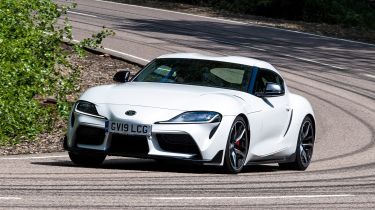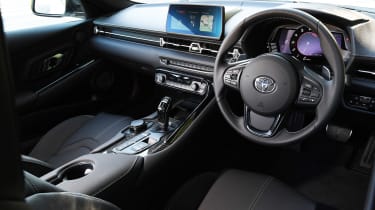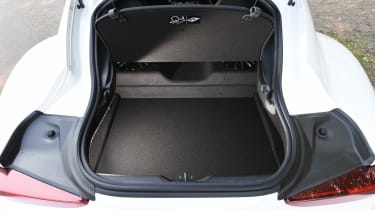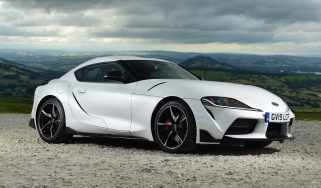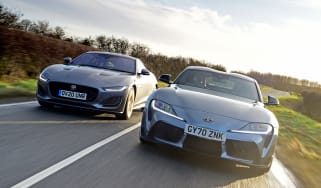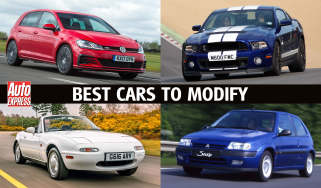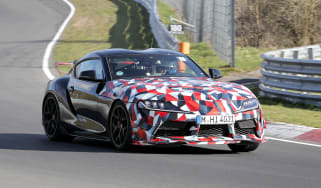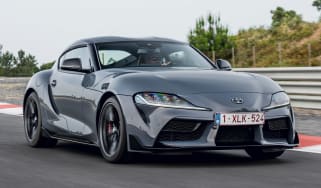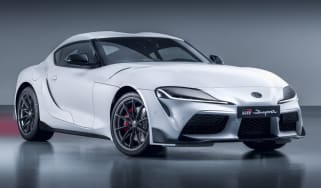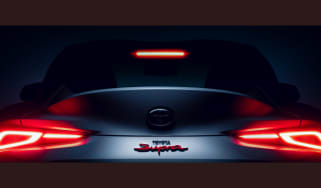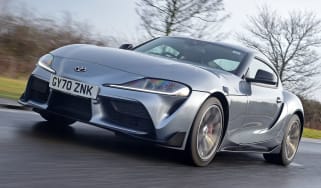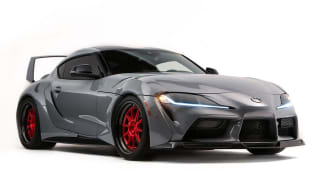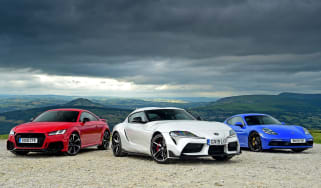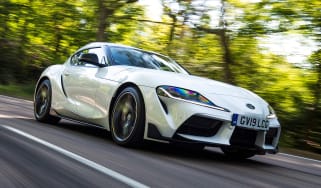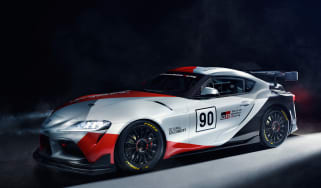Toyota Supra review
The Toyota Supra is a very capable sports car that uses shared BMW tech to its advantage
The Toyota Supra blends balance, agility, grip and poise with a punchy six-cylinder motor that delivers a hit of performance and (mostly) the stirring engine note we were after. Whether or not the Toyota collaboration with BMW that produced this Supra affects its authenticity, we’ll leave up to you. But there’s no doubting that this is a coupe with real talent and welcome character at a time when those traits in new cars are becoming less common.
The BMW M2 Competition is a rawer, more raucous rival and the Porsche 718 Cayman offers sweeter handling, but the Supra is a great car in its own right that works very well on British roads.
About the Toyota Supra
There are few truly iconic automotive names left in production, but it’s fair to say the Toyota Supra is one of them. It’s also fair to say, however, that the gestation of this fifth-generation model was, well, fairly drawn out.
The Supra launched in 2019 and the range expanded in 2022 with the addition of the manual gearbox option. Now it's had time to bed-in, we should probably address the elephant in the room, Toyota’s collaboration with BMW in the development of this A90-generation Supra sports car.
Both brands settled early on the characteristics for the shared platform. According to Toyota this meant a short wheelbase and wide track, to the point that the distance between the Supra’s wheels is actually less than a GT86’s, while its centre of gravity is lower, too.
Following the decision on the basic principles, both companies went their separate ways to develop the cars using a tool kit of parts and components. Or so the story goes.
Interestingly, the Supra’s chief engineer, Tetsuya Tada, told Auto Express at the time that the car’s chassis actually uses some components from the next-generation line-up of BMW M cars. This has intentions as a serious, pure sports car then, and the rest of the spec list backs this up.
Of course, with prices starting from around £50,000, the Supra has to do more than just drive well. This is a car many will use to commute in, as well as to explore the performance at the odd track day.
The range now includes a 2.0-litre, four-cylinder petrol unit, delivering 254bhp, along with the original 3.0-litre, six-cylinder motor which produces a significant 335bhp. While the 2.0-litre cars use the eight-speed automatic gearbox, there's a choice of either that transmission or a six-speed manual with the 3.0-litre engine.
The 2.0-litre and 3.0-litre automatic cars are offered with the Pro trim level. The manual version of the 3.0-litre model, however, is on sale in standard 'Supra' trim, with the Pro specification or as a Special Edition variant. Equipment levels are decent enough to mean that you don’t really need to splash out on the Pro unless you want a head-up display, wireless phone charger, full leather upholstery and other select goodies.
Engines, performance and drive
Toyota identified BMW as a partner for the Mk5 Supra project partly to stay true to the Supra’s heritage, as the German firm could supply the car’s traditional in-line six-cylinder engine. So, under the bonnet of the top-of-the-range car you’ll find a turbocharged 3.0-litre unit sending 335bhp and 500Nm of torque to the rear wheels through either an eight-speed automatic gearbox or a six-speed manual. Now, of course, there's also a 254bhp 2.0-litre option, another BMW engine paired with the automatic gearbox.
An electronically-controlled limited-slip differential is standard and adaptive dampers control the MacPherson strut front and multi-link rear suspension set-up, with two modes to choose from.
The Supra’s chief engineer Tetsuya Tada claimed that during the process of improving body rigidity, while there were targets (1.6 times that of the GT86), testing was also conducted on how it felt to drive. If it felt good, the engineers went with it. Incidentally, the Supra ended up being 2.3 times more rigid than a GT86 – and even stiffer than the Lexus LFA supercar - because that's what felt right.
You sense this on the move, too. The chassis feels highly rigid and it means the suspension is softer than you might imagine. Ride quality in the dampers’ normal mode is genuinely impressive, as the Supra skips over bumps with little fuss or deflection. Sport tightens the body control further still. But there’s a level of compliance retained in this setting that means the tyres stay in contact with the road to maximise grip and traction.
The 3.0-litre unit is a good fit for the car, but it's not a great motor. Tada outlined that if Toyota had tried to go it alone and develop a new straight-six itself, the project would have been delayed by three to four years – and due to incoming stricter noise regulations, the Supra would have been ghostly quiet.
Thankfully, it’s not. There’s a pleasant musicality to the six-pot’s note, firing and settling to a purposeful but smooth idle. There’s a brawny tone through the mid range – and it’s here where the BMW-sourced (but Toyota-calibrated) engine is at its best.
Peak torque is available from 1,600rpm and is sustained to 4,500rpm, so the 3.0-litre Supra pulls hard out of corners. However, it’s not all that rewarding to rev out. It feels strained beyond 5,000rpm, tightening up and revealing its forced induction – along with a faint on-boost whistle from the turbo. The enhanced engine note isn’t the most pleasant at higher revs, but then neither is the one from a Porsche 718 Cayman’s clattery flat-four.
The Supra's own four-cylinder option doesn't feel underpowered by comparison. The 2.0-litre engine noise lacks the same quality, and the electronically synthesised sounds pumped through the speakers seem a little over-the-top as a result, but the car starts with a rasping exhaust note that's can be heard clearly from outside. The 2.0-litre also brings a 100kg weight reduction over the 3.0-litre auto (70-80kg on the 3.0-litre manual), to 1,395kg. This helps the less-powerful Supra model excel in terms of its steering feel, the drop in weight really promoting the car’s agility.
The eight-speed gearbox does attract complaints. In auto mode it shifts smoothly, but upshifts are a little jerky when using the manual-mode steering wheel paddles, while downshifts are not as rapid as you’d like. The manual Supra is definitely the sweet spot in the range if the driving experience is your priority. The gearbox is based on a transmission from ZF with some bespoke components from Toyota and it works beautifully - precise with a short throw action that's a pleasure to use.
The flexibility of both powertrains is a major boon, giving you options to explore the chassis’ lovely balance. Be neat and drive tidily and the Supra will scythe through corners effectively. Even at normal speeds you feel the perfect 50:50 weight distribution and the adjustability in the chassis.Tada-san was very explicit about Toyota targeting the 718 Cayman as the Supra’s benchmark. That car offers communication, involvement and rewards you for driving well. In a different way, so does the Supra.
Engines, 0-60 acceleration and top speed
For peak performance you'll want to look at the Supra 3.0-litre straight-six automatic version, producing 335bhp and 500Nm of torque. It’s the same basic configuration as you’ll find in the hot Z4 M40i. The 0-62mph sprint takes just 4.3 seconds, while there’s plenty of punch low in the rev range which means overtaking manoeuvres just feel effortless. Top speed is electronically limited to 155mph. Go for the 3.0litre manual and the slower shifts mean 0-62mph takes 4.6s.
Although down on power to the tune of 81bhp (and 100Nm of torque), the 2.0-litre Supra model is no slouch, able to reach 62mph from a standstill in 5.2 seconds and with the same limited maximum speed as its big brothers.
MPG, CO2 and running costs
The Toyota Supra wasn’t created with low running costs in mind, but as a sports car that could easily be used every day, it has been developed to be fairly efficient. Official fuel economy for the 3.0-litre automatic version is quoted at 34.8mpg – better than the 29.4mpg offered by the four-cylinder Porsche 718 Cayman S and the 27.6mpg from the BMW M2 Competition. The Supra emits a claimed 188g/km of CO2, versus the 217g/km of the 718 Cayman S and the M2’s 226g/km.
Go for the 3.0-litre manual and fuel economy falls slightly to 32mpg with CO2 emissions of 198g/km. Customers opting for the 2.0-litre car will benefit from a claimed 39.7mpg maximum, with CO2 emissions of 167g/km.
Insurance groups
The entry-level Supra 2.0-litre Pro sits in group 34 for insurance, while the top-spec 3.0-litre Pro car is in group 37. The closely related BMW Z4 M40i sits in group 37, while the BMW M2 Competition sits in group 47 and the Audi TT RS in group 43-46, depending on specification.
Depreciation
Residual values for the Supra 3.0-litre model are strong. After three-years and 36,000-miles of ownership, customers should expect to recoup around 55% of the original list price paid on the 3.0-litre auto. The manual cars perform even better with expectations in the 57 to 59% range. The 2.0-litre car is predicted to retain 58% of its value of the same period.
To get an accurate valuation on a specific model check out our free car valuation tool...
Interior, design and technology
The Toyota Supra shares much of its mechanical underpinnings with the BMW Z4 and this shows in the Supra’s wide, short-wheelbase proportions. Outside, Toyota’s design pays tribute to the 1990s sports car of the same name – a long bonnet, large headlights and a squat rear end help give the new Supra a similar presence on the road and a high level of visual drama that’s undeniably important in this class. In fact, the only significant exterior difference between the four- and six-cylinder models is the respective standard 18- and 19-inch alloy wheels. The manual cars get red Supra badges on the rear.
While the Supra’s interior design is different to that of the Z4, with which it shares some of its DNA, in many areas, much of the componentry inside is BMW-sourced. That’s a good thing in some ways, as Toyota’s infotainment technology isn’t up to snuff, even in its most recent cars like the Corolla. Material and build quality fits the price tag though, as does the list of kit.
All Supra versions feature Toyota's 8.8-inch touchscreen infotainment system, with Bluetooth, sat-nav, a DAB radio and USB ports. The 2.0-litre Pro and 3.0-litre versions come with heated Alcantara sports seats, while the 3.0 Pro variant is treated to a leather upholstery upgrade. Extra luxuries for the 3.0 Pro car include a JBL audio system with 12 speakers, a head-up display and a wireless mobile phone charging function.
On the manual Supras, changes had to be made to the dashboard to accommodate the shifter. The top part of the centre console is wider and the controls for the infotainment, drive modes and electronic handbrake are all in different positions.
Sat-nav, stereo and infotainment
As far as the infotainment system goes, Supra buyers get a re-skinned BMW iDrive arrangement, with an 8.8-inch screen. Much of the other switchgear is from the Munich parts catalogue, too. The infotainment works slickly, while the adoption of BMW software means you get Apple CarPlay connectivity for the first time in a Toyota, but Android Auto is not offered.
On our Pro specification test car, the rearmost speakers caused a rattled over bumps – but this issue may have been specific to our early example.
Practicality, comfort and boot space
Inside, the Toyota Supra feels snug – there’s not a lot of room, which is fitting given that its designers claim to have been influenced by single-seater racing cars. Thankfully, all the important sports car attributes are present: a low driving position, supportive seats, a great steering wheel and good ergonomics. Visibility is good for a car of this type, offering a dramatic view forwards over that long bonnet.
There are just two seats, with a space behind them that can be used to extend the boot if you need to carry longer items, or store a couple of bags. It’s worth remembering that a pair of speakers take up a little space here on some models.
Dimensions and size
The Supra measures in at 4,379mm long, 1,854mm wide and 1,292mm high, with a relatively short wheelbase of 2,470mm. There’s a decent overhang at the front of the car, but low speed maneuvers are simple enough thanks to a standard rear-view camera and parking sensors. The Supra is longer than its Z4 cousin by a few millimetres, but the Z4 is marginally wider.
Leg room, head room & passenger space
The Toyota Supra’s seats are great, thanks in part to some more BMW DNA. They’re set low, are heated and ventilated as standard, and there’s lots of headroom, but the overall feeling in the Supra’s cabin is of being cocooned – a deliberate choice on the part of the designers.
You’ll be far more comfortable over a long distance in the Supra than in the more hardcore Alpine A110, but most of its other rivals are good match when it comes to interior space and day-to-day usability.
Boot space
The Supra’s 290-litre boot is big enough for weekend luggage, while a removable panel allows for longer items like golf clubs to be accommodated too. The aperture left by the opened rear hatch isn’t the most practical and the load lip is high, however. The BMW M2 Competition, by contrast, has about 100 more litres in its boot, which is accessible via a saloon-style bootlid with a much more manageable aperture and lip.
Elsewhere, storage in the Supra is good, if not particularly remarkable. One small niggle is that the cupholders sit behind the occupants’ elbows in the centre armrest – not the most elegant solution.
Reliability and safety
All Supra models come with a full suite of active safety and driver assistance systems. Forming part of the Toyota Supra Saftey+ pack are a pre-collision system (automatic emergency braking), adaptive cruise control, lane departure warning with steering assist, automatic headlights and road sign recognition. Supra Pro models add a head up display that helps the driver keep their eyes on the road.
Euro NCAP is yet to test the Supra for crash safety, but did award its BMW Z4 cousin a full five stars in 2019, with scores of 97% for adult occupant safety and 87% for child passenger safety.
The Supra is sold in too few numbers to have featured in our Driver Power owner satisfaction survey. However, Toyota itself was ranked an impressive 6th out of 30 manufacturers in our 2020 poll, with running costs and reliability rated highly by owners.
Warranty
Toyota’s impressive five-year/100,000-mile warranty applies here and therefore beats the standard three-year items offered on most of the Supra’s rivals. An extended warranty can be bought at extra cost as part of a package that includes free MoTs and roadside assistance among other perks.
Servicing
Servicing should be relatively pain-free compared to more prestigious rivals; finding a local dealer to do the work should be easy thanks to a large network. Costs are likely to run high, however – large tyres, performance-orientated brakes and a powerful engine will all keep prices relatively high. We’d expect Toyota to undercut its premium-badged rivals in this regard, though.
Toyota Supra alternatives
The Supra squares up against the Porsche 718 Cayman, Alpine A110, Audi TT and Jaguar F-Type, as well as its convertible-only BMW Z4 relative to some degree. Perhaps the biggest challenge comes from the excellent BMW M2 Competition – a harder-edged sports car that gets a ‘proper’ BMW M six-cylinder engine, more performance and a chassis that’s pretty spectacular both on the road and at the track. As a softer-edged everyday proposition though, the Supra makes a good case for itself.
